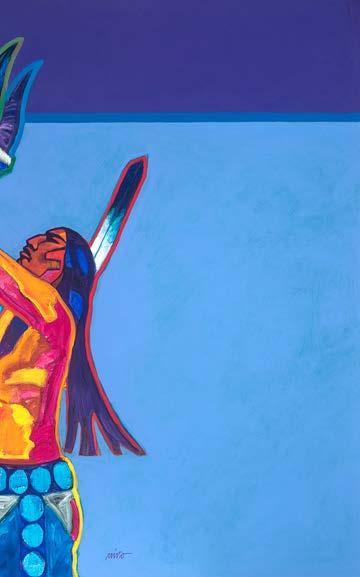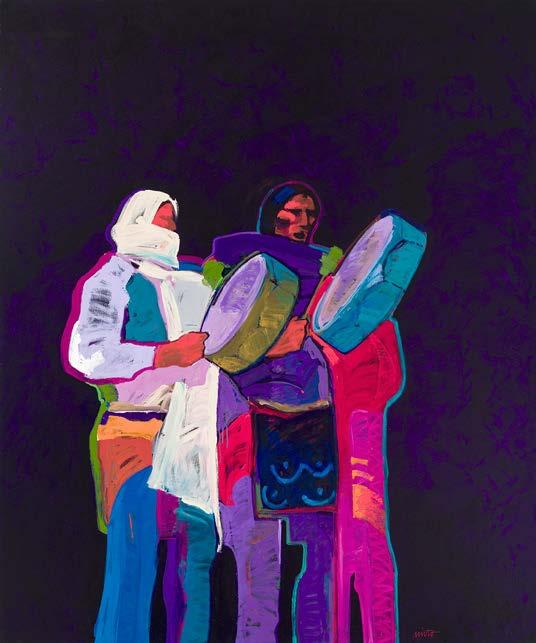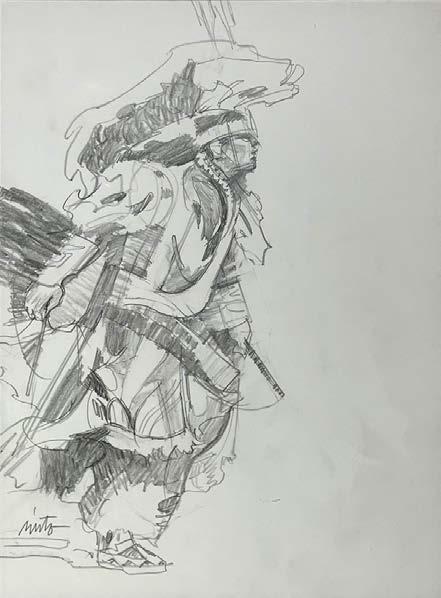IMAGES OF ANCESTRY

John Nieto is a leading figure in American contemporary art, celebrated for his emotionally resonant paintings of Southwestern, Indigenous, and wildlife subjects conveyed in heightened, expressive color. Nieto was inspired by both his own heritage as well as his deep study of the history and culture throughout the Southwest. Nieto’s New Mexican ancestry a mix of Native American (Mescalero Apache and Navajo) and Spanish can be traced back more than three hundred years.
Known as a brilliant colorist, Nieto conveyed his images of Indigenous and Hispanic leaders, artists, craftspeople, dancers, and wildlife using vivid, powerful hues that express the artist’s intention that these figures be worthy of honor by all. Applying his highly personal, emotional treatment of color to a wide range of subjects, Nieto’s art mirrors the complicated heritage of the Southwest as well as the intertwining threads of his own ancestry. He believed that, through his powerful colorations, he might help his audience to understand the nobility, dignity, pride, and hurt of Native Americans that many of his paintings quietly carry.
After spending most of his youth in New Mexico, Nieto earned a Bachelor’s Degree in Fine Art from Southern Methodist University in 1959. Inspired after visiting an exhibition of Fauvist art at the Dallas Art Museum that same year, Nieto travelled to Paris, visiting museums with collections of art by prominent Fauvist artists Henri Matisse and Andre Derain. His discovery of the fauvist treatment of color which prioritized striking, non-naturalistic color to communicate emotional meanings was crucial to Nieto’s development and the maturation of his style.
Over the course of his career, Nieto’s work was exhibited across the United States and in Europe, Japan, Latin America, and Africa. After participating in an exhibit at the John F. Kennedy Center for the Performing Arts in Washington, DC, John met with President Reagan in the Oval Office of the White House and presented him with his painting, “Delegate to the White House.” The work was hung in the White House for many years and was later included in the collection of the Ronald Reagan Presidential Library in Simi Valley, California. In 1994, Nieto received New Mexico’s Governor’s Award for achievement in the Arts, the state’s highest honor for a living artist. He received Southern Methodist University’s Distinguished Alumni Award in 2006. In 2021, Nieto was the subject of a 72-minute documentary film called, “John Nieto: An American Spirit Walk,” written and directed by one of his sons, Anaya Nieto. Today, Nieto’s work is represented in prominent museum and private collections across the country.

When an artist devotes their life to painting subjects tied to a distinctive world view and a cultural presence on the landscape, they evoke its mysteries, its depths, as well as indicating by their devotion a profound love for them. John Nieto (1936-2018), was among a generation of Native artists who rose to prominence in the 1960s through the 1980s and merged modern and contemporary aesthetics with Indigenous subject matter. But, as he turned to a world he knew for inspiration, he encountered one that opened him to new modes of expression and, he strove to synch them.
If the Fauves came back and saw the impact of their work on this generation of artists, one suspects “the wild beasts” of the early 20th century would be delighted. Fauvism as a formal movement lasted only from about 1905 to 1908, but Nieto introduced its dramatic color choices, abandonment of exact realism, emotional resonance, and embrace of abstraction to a scene that would, by the end of the 1980s, provide younger Native artists with a lasting foundation rooted in 20th-century Indigenous experience.
A contemporary of Fritz Scholder (1937-2005) and T.C. Cannon (1946-1978), Nieto helped to usher in an era of Native painting that was centered on pop aesthetics and expressionism. Its impact still endures. But take an acrylic like Nieto’s Cut Foot (1991), or his portrait of Spotted Horse (1989), and the abstraction is refined, in service to the greater subject. In the latter painting, a halation of fiery orange-red delineates the outer edge of the portrait, highlighting it so that it pops, three-dimensionally, from a monochromatic background. The abstraction is contained within the shapes, and he uses it to differentiate the various components of the subject’s form. Abstraction in the shoulder, for instance, distinguishes it from the chest, as do the artist’s color choices.
Nieto used these two elements color and abstraction to provide his subjects with nuances of shading and light that ran counter to artistic tradition. For example, if conventional wisdom dictates that white in shadow, for the sake of realism, be rendered blue, he’d opt perhaps for magenta, or maybe a pale green, or even a golden yellow.
Unlike Cannon, in whose similar, foundational subject matter of the contemporary American Indian one senses the direct influence of the older artist, Nieto often vanished setting and place for a more focused treatment. The subject in situ, or a particular context, was
of less concern to him than it was in its singularity. Like a point in space-time where matter becomes infinitely dense, his subjects contain worlds within. And, so, they are more alive and electric than their backgrounds. Nods to landscape appear here and there, as bands of color representing the horizon. And his faces, envisioned often as a multi-colored patchwork of features in shadow as in his portrait of Crow Eagle (2007), hit the viewer with an emotional impact, their stoicism reflecting a serene quality.
“There’s no formula for my faces,” he said of his work. “I paint the dance of identity around the pan-Indian bone structure of all Native Americans. I am painting a person, but I am painting much more than that.”
Crow Eagle, with his deep indigos, lines of green, and flashes of orange and yellow, contrasts with the pale blue background, and the figure’s dark hues create a depth, inviting the viewer into an interior world, where the blue of an ornament worn on his neck echoes the background color and provides a sense, as in life, of inner and outer continuity.
Often using halation to trace the outlines of forms, his paintings take on, at times, the characteristics of stained glass, and recognizing that feature in his own work, he turned to the medium. The Potter (1984), for instance, is a stained-glass rendition of his painting Pueblo Potter (1999), and a comparison reveals how well Nieto’s sensibilities as a painter translate into other media. In this case, it’s a medium he was evoking beforehand, and it seems only natural that he would, in time, apply an opalescent and stained-glass way of seeing his subjects to the medium of glass itself. Add to that a career that included drawing, etching, lithography, silkscreen printing, and sculpture, and Nieto was a well-rounded master of his craft. Born in Denver, Colorado, to a family of New Mexican ancestry, which included Mescalero Apache, Navajo, and Spanish heritage, Nieto studied for his BFA from Southern Methodist University in Dallas, Texas, in 1959. That same year, he saw an exhibition, Les Fauves , at the Dallas Art Museum. Struck by their unapologetic defiance of Academic art and bold use of colors, he pursued his interest in these artists more deeply. Working as a graphic artist while in the U.S. Army, he visited Paris, France, taking in the work of Fauvist influences and its predecessors, excited by the works of Henri Matisse, Paul Gaugin, and Vincent Van Gogh.
Responding to a request made to him in 1960 by his Mescalero Apache grandmother to “paint [her] people,” Nieto concluded that creating work with this form of intense color to rivet attention, grasp emotions, and galvanize memory would be his life’s calling. Nieto says about that pivotal moment: “That is what set me on painting Native American subject matter. I made it my business to be an authority on the Indian part of my heritage. … I was being told that color, my color, was really okay. In retrospect, it was what psychologists call a ‘peak moment’ when the world is at peace, and you are at peace within it.”
In essence, though, Nieto’s work on the whole is an homage to more than his own ancestry, although ancestry is a vital component to his work. And it’s more than an emphatic shift from depictions of a “traditional” Native American in full Plains headdress, who’s one with their horse, holding high in offering a feather or a pipe whose smoke is in conversation with air and sky. Nor is it reflective of another end of the “othering” spectrum that accompanied 19 th and early 20 th -century depictions of Native peoples by academically trained artists: Natives as noble savages.

It was up to Indigenous American artists like Nieto to find affinity with the radical departures represented by artists like the Fauves (or later in Nieto’s life after coming back from a series of strokes in the early 2000s, the Cubists) and use them to create work that was grounded in the contemporary moment. This was, also, a radical departure. An Indian in a headdress, however, wasn’t a subject he sought to avoid. He recognized that, today, it’s reflective of traditions within a living culture. Even in traditional dress, his portraits were of people in a modern world.
Scholder and Cannon took a similar approach. Like Nieto, Scholder’s abstraction could also be self-contained within a figure set against a monochrome or ambiguous background. But their color choices were distinct, with Nieto favoring a brighter, more brilliant use of it and Scholder favoring somber tones. As for their subjects, each brought in a wide array of personal idiosyncrasies, such as Scholder’s penchant for Egyptology, which he sometimes referenced in paint. Nieto’s Southwestern Scion (2005) seems a reference to Scholder’s 1971 color lithograph Indian at the Bar, which is noted for being an unextraordinary depiction of an anonymous Native American man, with a can of Coors beer in his hand. Absent are all the trappings seen in a traditional, non-Native depiction. Nieto’s 2005 painting of a similar scene is different in tone, not just because of his more strident use of color, but because of its title. The word “scion” suggests an inheritance of noble heritage, yet the man is no more remarkable than Scholder’s save a gun in his hand. In combination, title and imagery suggest he’s a defender of that heritage. It’s not a self-portrait, but it could be if the artist trades out a sixshooter for a brush.
But tribute and homage is a driving force of Nieto’s art, and it extends beyond the heritage and ancestry of his lineage to humanity on the whole, connecting past and present in its style and subject. His brilliant, colorist works bring together his contemporary aesthetic with his spiritual reverence, paying tribute to the multidimensionality of his subjects. He defies clichés without overthinking his approach, and delivers a profound emotional impact through his distinct personal and artistic point of view.
“My art is the result of an emotional involvement with my subject matter rather than a cerebral one,” he said. “My colors express my worldview, which is positive and optimistic. My colors celebrate universal, enduring human values.”
— Michael Abatemarco




























Ship Rock, 1999








1936- 2018
EDUCATION
1959 Bachelor of Fine Arts, Southern Methodist University
SOLO EXHIBITIONS
2023 Images of Ancestry, LewAllen Galleries, Santa Fe, NM
2022 Forces of Color and Spirit, LewAllen Galleries, Santa Fe, NM
2021 Four Decades, LewAllen Galleries, Santa Fe, NM
2020 The Legacy Paintings, LewAllen Galleries, Santa Fe, NM
2019 Ventana Fine Art, Santa Fe, NM (also 1987-2018)
2014 Altamira Fine Art, Scottsdale, AZ
Altamira Fine Art, Jackson Hole, WY (also 2009-2013)
2012 Nieto Fine Art, San Francisco, CA
2009 Contemporary Visions of the West: The Art of John Nieto, Booth Western Art Museum, Cartersville, GA
2008 Mountain Trails Gallery, Jackson Hole, WY (also 2006 and 2007)
2002 Adagio, Palm Springs, CA (also 1995-2001)
1996 J. Cacciola Gallery, New York, NY (also 1983-1995)
William Y. Clements Center for Southwest Studies at SMU, Dallas, TX
1993 University of Utah, Salt Lake City Museum
1986 Enthios Gallery, Santa Fe, NM (also 1980-1985)
1985 John Nieto: Retrospective, Wheelwright Museum of Indian Art, Santa Fe, NM
1983 Governor’s Gallery, State Capitol Building, Santa Fe, NM
1982 Savage Gallery, Scottsdale, AZ (also 1980 and 1981)
1989 Axis Gallery, Tokyo, Japan
1981 10 Contemporary Artists, Taos, NM
GROUP EXHIBITIONS
2012 Art in Embassies Program, Port Luis, Mauritius
Buffalo Bill Museum, Whitney Gallery of Western Art, Cody, WY
2011 Nieto Fine Art, San Francisco, CA
2010 Nieto Fine Art, San Francisco, CA
2009 6th Annual Southeastern Cowboy Gathering (John Nieto featured artist), Booth Western Art Museum, Cartersville, GA
2008 25th Anniversary All Artists Show, Ventana Fine Art, Santa Fe, NM
The Southwestern Art Collection of Charles and Jeanette Gilchrist White, Lakeview Museum of Arts and Sciences, Peoria, IL
2007 Museum of Contemporary Art, Hot Springs, AR
Booth Western Art Museum, Cartersville, GA
Small Works Show, Ventana Fine Art, Santa Fe, NM
2005 Jackson Hole Museum, Jackson Hole, WY
Ventana Fine Art, Santa Fe, NM
Small Works Show, Ventana Fine Art, Santa Fe, NM
2002 The Blanton Museum of Art at the University of Texas at Austin, Austin, TX
“Peace and Loyalty,” commissioned by the Salt Lake Organizing Committee, “Olympic Power Suite,” Commemorative Artwork Commissioned in Honor of the Games, Salt Lake City, UT
2001 Capital Art Foundation, Santa Fe, NM
New Mexico Museum of Fine Arts, Santa Fe, NM
1992 Pageant of the Masters, Laguna Beach, CA
Native American Invitational Exhibition, “Walk In Beauty” Santa Fe, NM
1990 Art of Albuquerque, Group Exhibition, Museum of Albuquerque, Albuquerque, NM
1985 The Art of the Native American, Owensboro Museum of Fine Art, Owensboro, KY
Pageant of the Masters, Laguna Beach, CA
1984 Nabisco Show, Nabisco Corporate Headquarters, NJ
Marine Corps Museum, Washington, DC
1983 Contemporary Native American, The Heard Museum, Phoenix, AZ
1982 Santa Fe Festival of the Arts
Window Exhibit, Lord and Taylor, New York, NY
Denver Art Museum, Denver, CO
American Indian Contemporary Art, Smithsonian Institution, Washington, DC
Night of the First Americans, John F. Kennedy Center for the Performing Arts, Washington, DC
United States Embassy and the United States International Communications Agency, Barbados
Cabo Frio International Print Biennial, Cabo, Brazil
1981 Salon d’Automne, Grand Palais, Paris, France
Le Salon Des Nations a Paris, Centre International D’Art Contemporain, Paris, France
20th Century American Indian Artists, Kimball Art Center, Park City, UT
Native American Works, Pensacola Museum of Art, Pensacola, FL
1980 Gallup Inter-tribal Ceremonials, Gallup, NM
1979 Philbrook Museum, Tulsa, OK
1961 Dallas Museum of Fine Arts, Dallas, TX
SELECTED PUBLIC COLLECTIONS
Arts and Science Museum, Statesville, NC
Booth Western Art Museum, Cartersville, GA
Buffalo Bill Museum, Cody, WY
Capital Art Foundation, Santa Fe, NM
Denver Art Museum, Denver, CO,
Fenimore Art Museum, Cooperstown, NY
Institute of American Indian Art, Santa Fe, NM
Jackson Hole Museum, Jackson Hole, WY
Marine Corps Museum, Washington, DC
Montclair Art Museum, Montclair, NJ
Museum and Art Center, Sylacauga, AL
Museum of Contemporary Art, Hot Springs Arkansas
National Museum of Wildlife Art, Jackson Hole, Wyoming
New Mexico Museum of Fine Arts, Santa Fe, NM
Palm Springs Art Museum, Palm Springs, CA
The Blanton Museum of Art, Austin, TX
The Discovery Center, Fort Lauderdale, FL
The Heard Museum, Phoenix, AZ
 Quanah Parker, 1977, acrylic on canvas, 30" x 24"
Quanah Parker, 1977, acrylic on canvas, 30" x 24"

